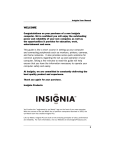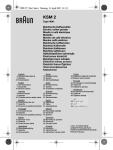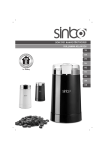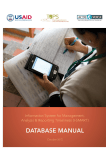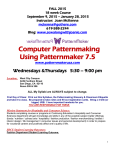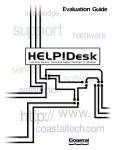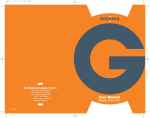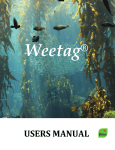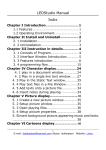Download The Situation - Carnegie Mellon University
Transcript
Consumer Action and Response Team – Final Consulting Report Student Consultant, Matt Mlinac Student Consultant, Simon Yau Shing Huang Community Partner, Paul Freund Community Partner, Virginia Mayo The Situation Organization The Consumer Action and Response Team, known as CART, is located at 938 Penn Avenue in downtown Pittsburgh. CART was founded in September 1998 as a collaborative project of National Alliance of the Mentally Ill (NAMI) Southwestern PA and Renaissance Center, Inc. On January 1, 2002 CART became solely a project of NAMI Southwestern PA. CART is a human relations organization funded by Allegheny County to provide feedback about behavioral health services and programs. Through interviews, CART assesses consumer satisfaction of mental health rehabilitation and drug and alcohol rehabilitation programs. CART has 15 employees and works with a budget of about $500,000. Funding is provided by Allegheny County Department of Human Services and Community Care Behavioral Health Organization (CCBHO). Through its work, CART directly serves approximately 2600 behavioral health consumers each year and indirectly serves the entire public by making annual reports available to everyone. CART's vision is that consumers and providers will dialogue regularly about improvements that could be made in existing behavioral health services. This dialogue will result in the best possible services for consumers who will become empowered to make choices and participate in their own recovery. CART began interviewing consumers recently discharged from Mayview State Hospital as part of a Community Hospital Integration Projects Program (CHIPP) initiative; collaboration was designed to create services in the community for a group of people discharged from Mayview beginning in 2001. There are seven employees involved in CHIPP and they presently serve 55 consumers. My Community Partner and I are particularly assigned to the CHIPP project. CART's role is to interview this group of consumers every three months in order to assess their degree of satisfaction with their services and general quality of life. This information is fed back to the decision-makers to help them assess the community adjustment of the people discharged from the hospital. Program The main task that CART does is to interview consumers who are using behavioral health services. From these interviews, CART learns about these consumers' satisfactions and dissatisfactions about their services. CART then reflects these responses from consumers back to the service providers so that the service providers have a better idea on what aspects of service they are doing well and what aspects could be improved. Most interviews are conducted at the location of behavioral health service, although some are conducted on the phone from CART’s office. From information obtained through these interviews, CART generates provider-specific reports, quarterly reports, and annual -----------------------------------------------------------------------------------------------------------Consumer Action and Response Team: Final Consulting Report 4/30/2003 Simon Yau Shing Huang, Student Consultant Matt Mlinac, Student Consultant Page 1 of 16 reports. Sometimes CHIPP generates consumer-specific communications instead of formal reports. The provider-specific reports recommend areas in which to improve care and necessitate feedback from the providers. Both the providers and the county examine the quarterly reports, and the annual report is made for the interested public. Twice per month CART, county representatives, and providers gather for an accountability meeting in which the reports are discussed in full. The accountability process for the CHIPP project has been in the process of fine-tuning during our Community Partnership. A distinct advantage of CART is that CART is independent of provider organizations so that comments from consumers can be objectively reflected to the providers. Exclusive of CHIPP, the interviews conducted by CART consist of 45 multiple-choice questions and 9 open-ended questions. For each provider report, the multiple-choice questions are tabulated statistically with Microsoft Excel. Then the open-ended questions are examined to determine areas of improvement for the provider. For the quarterly reports, the multiple-choice data is tabulated for all providers with Excel. The open-ended questions are categorized by hand. The reports are created with Microsoft Word, with all of the statistical information inserted. All of the reports are printed out and mailed to the recipients. As for the CHIPP program, CART interviews consumers who are discharged from Mayview State Hospital. These consumers are interviewed four times a year in their first year after being discharged from Mayview. In the second year, they are interviewed twice and only once in the third year. The longer a consumer has been out from Mayview hospital, the more they are used to living in the society so the frequency of interviews reduces after each year. Ideally, after these seven interviews through three years, the consumers would have overcome the difficulties of the transition from being in a hospital back into the society. The interviews consist of 7 demographics questions and 22 openended questions. All questions have a quantitative answer and the 22 open-ended questions have additional qualitative comments. This is the second year of CHIPP and they are serving 55 consumers. For now, the quantitative parts of the interviews are stored using MS Excel. The qualitative parts of the interviews are stored using MS Word. These files are used to create the quarterly reports and annual reports. Computers are usually used for data entry, writing reports and other word documents, printing out forms, sending e-mails and browsing the Internet. Staff CART is headed by Paul Freund, the Project Director. Also managing the project are Virginia Mayo, the Team Supervisor, Skip Alberts, the Project Coordinator, and Barb Reith, the Administrative Assistant. Also on staff are Carol Wivell, the CHIPP Liaison, and Barb Fellows, the Site Coordinator. In addition to these, CART employs 7 interviewers and a receptionist. The executive director of NAMI (the parent organization) is Harriet Baum. Sandra Hein is also employed by NAMI but does a considerable amount of technical work for CART. There are about fifteen employees for CART and about seven are involved in CHIPP. Most employees have access to computers and the Internet while some have to share -----------------------------------------------------------------------------------------------------------Consumer Action and Response Team: Final Consulting Report 4/30/2003 Simon Yau Shing Huang, Student Consultant Matt Mlinac, Student Consultant Page 2 of 16 computers. A lot of the employees are interviewers. Interviewers record the interviews using a form in paper. For the CHIPP interviews, the interviewer does the data entry for qualitative comments himself, typing out the interviews using MS Word. The quantitative data is entered by a staff member other than the original interviewer. For Team Supervisor and Project Director, their responsibilities include mostly administrative works and creating various reports. They use computers for e-mail, browsing the Internet and creating different kinds of word documents. Technical backgrounds for employees vary. Some employees have had experiences using computers while others might have no knowledge of computers at all. Usually, when employees are new, NAMI (CART's Parent organization) sends someone over to CART to train her for a few days and teach her how to use the computers. If further training is required, employees sometimes go to community colleges to take a course, for example, to learn MS Excel. Technical Management The Director of Administrative Services of NAMI, Sandra Hein, is responsible for managing technical environment. Whenever CART has any problem with computers, they ask Sandra to come and fix the problem. If there are circumstances when Sandra is not able to solve the problem, they employ technical consultants to help solve the problem. Barb Reith backs up the file server nightly. Backup tapes are rotated on a 10day (2 week workweek) basis. Technical Planning Sandra Hein is the only person who is responsible for all the technical issues. As for now, there really is not any formalized plan. She worked with a board member to develop the web site. NAMI controls CART’s budget and finances. Their goal is to eventually upgrade all the computers, as funds are available. In addition to this, a further goal is to streamline processes using the technology they have put into place. Their network has only been installed about a year. Prior to that they only had a few computers and information was shared through disks. Decisions regarding technology planning are done in conjunction with Sandra Hein and Paul Freund, Project Director. When planning has been decided, they present it to the Executive Director for approval. If purchase of equipment is involved, they have to get this approved by Allegheny County, their funder. Internal and External Communications The network was set up about a year ago and files can now be shared internally. There is a drive that everyone has access to and is able to share files there. There is not really an organized way to manage all the e-mail and web addresses of the donors, funders and volunteers. CART sends all of its reports out as hard copies. -----------------------------------------------------------------------------------------------------------Consumer Action and Response Team: Final Consulting Report 4/30/2003 Simon Yau Shing Huang, Student Consultant Matt Mlinac, Student Consultant Page 3 of 16 Information Management The most critical information to CART is the records of the interviews that they have had with their consumers, since interviewing is the main task for CART. For now, the quantitative parts of the interviews are stored into MS Excel files and are presented in tables and graphs in the annual reports. The qualitative parts of the interviews are typed up using MS Word and then printed, with both the hard and soft copies being stored. In the interviews, some of the information about consumers is entered repeatedly but most information can be entered just once. Currently CART has a database created by a group of Carnegie Mellon Information Systems students. The database was created at the end of last year specifically for CART. The design of the system is a web interface through which CART employees can enter interview response information. The database has the capability of storing all of the interview information that CART collects for analysis and reports. However, the system does not work properly. Problems/Opportunities 1. Build a database for the CHIPP project using MS Access Description: CHIPP’s mission is to interview people who are discharged from Mayview State Hospital to get responses about the behavioral health services they are receiving from various service providers. There are 30 questions in an interview. There are two parts to the interviews. The quantitative part uses numbers to code different answers to each question. For example, 1 might be yes, 2 might be no, 1 in another question might indicate age category 18-21 years old. These data are stored using MS Excel files. For some of the questions there are comments recorded as narrative, rather than just “yes” or “no”. These qualitative data are stored using MS Word. A problem is that data is not stored together and it is hard to retrieve or make any analysis. We decided to build a more centralized database which can also do some analysis on the data. This should help the CP to manage their data in a more organized way as they will only have one MS Access file to deal with instead of many MS Word and MS Excel files to manage. They also will not have to go through several folders and files to find information that they want, since everything about the interviews is in the MS Access database file. This will help CHIPP to reflect these responses from interviews to the service providers more efficiently and will save a lot of time in creating quarterly and annual reports. Description of Work Task: We decided to build a database using MS Access, which can integrate the quantitative and the qualitative parts together. MS Access will also be able to analyze the data using various queries. We will design and implement the database together with our community partner. We will help our CP to learn MS Access so that the database will be sustainable after the period of partnership. Approach: - Design and draw out the entity-relational diagram and tables that represents the database -----------------------------------------------------------------------------------------------------------Consumer Action and Response Team: Final Consulting Report 4/30/2003 Simon Yau Shing Huang, Student Consultant Matt Mlinac, Student Consultant Page 4 of 16 - Explain to the CP the entity-relational diagram and explain to her the basic concept of a database Create tables and explain to the CP how to use wizards to create tables Try doing sample data entry to ensure that the database is correct and all the necessary attributes are stored. Then enter the actual data Create simple queries and explain to the CP at the same time. After she understands it, try more complicated queries or any data analysis that she needs for the reports using the wizards Create a list of queries that CHIPP needs Create forms in MS Access to make data entry easier Create reports in MS Access for each individual interview and quarterly report Make sure that the CP can not only use the database but also understand the theory behind it Expected Outcome: - CP will understand the entity-relational diagram, tables and the Access database - CP will be able to create tables using the design view - CP will be able to manage the database and create various queries if necessary - Reports can be generated more efficiently - There will be one centralized database instead of using separate files - CP will understand database and Access well enough to train other employees in the future - CP will be able to make changes in the database, add new table, create new queries, change the format of forms and reports in the future if necessary Anticipated expanded capacity: As a result of the implementation of the database, a lot of time will be saved in gathering information for creating the quarterly and annual reports. This not only will make the operations more efficient but also will give the CP more time to take care of other business related to CHIPP. This will make the data more centralized and much easier to analyze. Not only will the result help the organization: the CP will acquire a much better understanding of technology throughout the process. After the period of partnership, the CP should have more confidence in learning new software and also realize the power of technology. With the use of technology labor cost can be cut down and time can be saved. This can motivate the CP to be more interested in technology and learn more in the future. As a result of this expanded capacity, the CP can use technology to better accomplish their mission. -----------------------------------------------------------------------------------------------------------Consumer Action and Response Team: Final Consulting Report 4/30/2003 Simon Yau Shing Huang, Student Consultant Matt Mlinac, Student Consultant Page 5 of 16 Analysis of Outcomes and Recommendations Task 1: Build a MS Access database to store data from CHIPP interviews The consulting task was to build an MS Access database for CHIPP, a program in CART, to store the data from interviews. These data included both the numeric and narrative answers. Outcome 1: Having a more centralized database CHIPP used to store data from interviews in MS Word files for the narrative part and MS Excel files for the quantitative part. With an MS Access database, data is more centralized. Instead of having a MS Word file for each person's interview, which was harder to manage, there is only one big database that stores everything from all interviews. Outcome Evidence: My CP and I built a MS Access database together. We designed it according to the needs of the current interviews and reports. My CP learned how to create tables, make queries and reports in MS Access throughout the partnership. She will be able to teach other staff members how to use the system utilizing the User Manual that we developed for this purpose. My CP and I designed the database tables together and she created the tables using the design view. We created the individual interview report for CHIPP using the report wizard in MS Access. Sustainability: As I have mentioned, my CP has been learning MS Access throughout the partnership. She should be able to get familiar with the database by the end of the partnership and should be able to teach the staff members who need to use the database. The User Manual that we produced will help with this teaching and will help the CART interviewers to perform tasks. My CP has obtained some textbooks in MS Access. She can always learn more from the books when she comes across problems in the future. Expanded Capacity: Having a more sophisticated database like an MS Access database makes the data entry much easier since interviewers are dealing with just one file now. Also, it gives them more power to group different information together using various queries. For example, they used to store the numeric answers and the narrative answers to the interviews separately and the individual interview report would only present the narrative part. The numeric answers were only presented in the quarterly reports. With the new database, there is a query that can help CART gather and present both the numeric and narrative information together to create an individual interview report that provides more information. Outcome 2: MS Access gives them the ability to analyze data better My CP and I designed the database such that comments from interviews are now categorized into positive comments, negative comments and neutral comments. With the -----------------------------------------------------------------------------------------------------------Consumer Action and Response Team: Final Consulting Report 4/30/2003 Simon Yau Shing Huang, Student Consultant Matt Mlinac, Student Consultant Page 6 of 16 design of the database and the power of queries in MS Access, my CP can better analyze the data. For example, they can get all the positive comments for a particular question from all interviews in a quarter. Before the partnership, they would have to go into every single MS Word file that contains an individual interview and find out all the positive comments. There are also other queries that can help them analyze the data and gather information more efficiently. Using the report function in MS Access CART can now create better-organized individual interview reports as well as more complete and betteranalyzed aggregate reports. By having a single data location the database greatly enhances CART’s ability to track trends in the experiences and opinions of the consumers interviewed. Outcome Evidence: My CP and I designed some queries and reports. All the staff have to do in the future is to change the criteria (the WHERE statement in SQL) like Consumer ID, Quarter, Year or Question Number in the queries in order to create different queries. Sustainability: As I have mentioned, the queries are very easy to use. My CP does not know everything about the queries but she knows enough to be able to make changes. Also, my CP has some books in Access that she can always refer to when she comes across any problem in the future. The User Manuals that we created will help staff to perform the tasks. Expanded Capacity The ability to make queries and analysis makes CHIPP quarter and annual reports easier to create. Also, it gives them more power to make analysis of the data, something that was very hard to do with their old way of storing information. With the ability to make analysis, the data would give them more information. For example, they can even compare answers from previous years to this year. This makes what they are doing more meaningful. They can also better reflect the situation of the consumers to the service providers and the county. Recommendation The CP has learned some basic functions in MS Access throughout the partnership. However, there are still things in MS Access that are not very clear to the CP. The CP will be the person in charge of the database in the future and other interviewers will be responsible for entering data into the database. I recommend that the CP and a few interviewers who will be using the database take some classes from community colleges to learn more about MS Access. An alternative is to have the CP and those few interviewers learn MS Access through some tutorials on the Internet or through books. They can research the local community college for classes in MS Access. Rationale The purpose is to have a few people in CHIPP to be familiar with MS Access and feel comfortable teaching it to other members in the organization. Having a -----------------------------------------------------------------------------------------------------------Consumer Action and Response Team: Final Consulting Report 4/30/2003 Simon Yau Shing Huang, Student Consultant Matt Mlinac, Student Consultant Page 7 of 16 couple staff members be familiar with MS Access, CHIPP could aim to start a training program in MS Access. People who are familiar with MS Access will be teaching other interviewers who are not as familiar with MS Access on a 1-to-1 basis. Although the interviewers do not have to understand the whole picture of the database to be able to enter data, this would give the interviewers a better understanding of the database and feel more comfortable using MS Access instead of just blindly entering the data. This will also reduce the possible problems of interviewers who are not familiar with MS Access messing up the database. Resources Some possible websites to learn MS Access are: http://www.fgcu.edu/support/office2000/access/ http://www.bcschools.net/staff/AccessHelp.htm. Sandy Hein, at the NAMI office, has a few books of different levels that teach Access. There is an Access book that teaches really basic Access and has a lot of pictures on it. Beginners will probably find it easier to start learning with that book. My CP can think about borrowing some of the books and start teaching the staff with the simple one and introduce other books with more details as the staff members get more familiar with Access. There are also some websites about taking workshops in community college. This is the link to the list of computer workshops offered in Community College of Allegheny County: http://www.ccac.edu/course_list.aspx?&term=ANY&subject=Computers+One+Day+Workshop Other Recommendation I recommend CART to implement a technology plan. As of now, CART does not have any kind of technology planning. The only person who is responsible for anything related to technology is Sandy, who is from CART's parent organization NAMI. Whenever there is a problem with technology, they call in Sandy. If she cannot solve the problem, they seek help from other consultants. They bought some new computers a year ago but there really is not any planning in the direction of where CART is going in terms of technology. They can either have Sandy, or the next student consultant come up with a technology plan. They can also hire professional consultants to create a more sophisticated plan. Rationale Having a technology plan can help CART to work more efficiently to reach the goals of the organization. Developing a plan in advance to make better use of technology could help CART to obtain increased funding for technology. Resources Here are some of the issues that they can deal with. They can come up with a technology training program with various staff members. Depending on each -----------------------------------------------------------------------------------------------------------Consumer Action and Response Team: Final Consulting Report 4/30/2003 Simon Yau Shing Huang, Student Consultant Matt Mlinac, Student Consultant Page 8 of 16 staff's responsibility, they can come up with a list of things that they need to do, a user manual for the tasks that they need to do and ideally, in a long term, a training program for different staff who need different computer skills. Since CART needs to store backups of the MS Access database and floppy disks probably cannot store this much data, I would recommend purchasing an external zip drive so that it can be moved easily from one computer to another. First, the computers need to be checked if the computers have a free USB or parallel port to determine what type of connection the zip drive will have. A USB port is the same type of port used when connecting the keyboard or mouse. The parallel port is the same type of port used when connecting a printer. Zip disks would also need to be purchased to use with the zip drive. Installation should be as simple as connecting the zip drive and installing its software. Once the zip drive is connected, it will be easy to use since it is very similar to storing files on a floppy disk. All the hardware can be purchased at any computer store such as CompUSA or online through amazon.com or Best Buy. Below are a few links to zip drives and disks on Best Buy: • The following are links to zip drives. I would recommend 100 MB capacity since that is what the current computer with a zip drive is. Iomega 100MB External Parallel Port Zip Drive (PC) http://www.bestbuy.com/Detail.asp?m=488&cat=511&scat=&e=1100867 0 or Iomega 100MB USB-Powered Zip Drive http://www.bestbuy.com/Detail.asp?m=488&cat=511&scat=513&e=1108 0091 • Zip disks are needed to use the zip drive. Here is an example of a zip disk for a reasonable price. Fuji Zip Disks (2-pack) http://www.bestbuy.com/Detail.asp?m=488&cat=516&scat=518&e=11008549 Another area that they can look at is to update their computer regularly. They should try to delete their unused files, regularly upgrade their software and aim to upgrade their computers. Some of the computers are slow and are using older versions of MS window and MS office. They should try to upgrade their computers regularly if they have enough funds in the budget. They do not have computers for everyone now. Maybe they can aim to get everyone a computer in a few years. 1 Resources about Zip Drive in other recommendations are based upon a recommendation given by Nancy Chen, the consultant who worked with Christian Life Skills this semester. -----------------------------------------------------------------------------------------------------------Consumer Action and Response Team: Final Consulting Report 4/30/2003 Simon Yau Shing Huang, Student Consultant Matt Mlinac, Student Consultant Page 9 of 16 About the Consultant: My name is Simon Yau Shing Huang. I am a senior in Electrical and Computer Engineering in Carnegie Mellon University. I will be pursuing my master degree in Management and Information Systems in Carnegie Mellon University. I hope to find a job as a programmer in a business environment after I graduate. -----------------------------------------------------------------------------------------------------------Consumer Action and Response Team: Final Consulting Report 4/30/2003 Simon Yau Shing Huang, Student Consultant Matt Mlinac, Student Consultant Page 10 of 16 Appendix A – Use Manual for data entry User Manual for data entry 1. Open up the Access database by double clicking the Icon on your computer desktop or by going to “programs” on the start menu and double clicking. 2. Single click on “Forms”, which is under “Objects” You would then see the above screen. Then double click on Int-General and you will see the next screen. -----------------------------------------------------------------------------------------------------------Consumer Action and Response Team: Final Consulting Report 4/30/2003 Simon Yau Shing Huang, Student Consultant Matt Mlinac, Student Consultant Page 11 of 16 This is a form for interviewers to enter data from interviews into the database. The upper part of the form includes general information like the consumer’s ID, date and quarter etc. The lower part of the form includes the answers from interview. The screen above shows an interview that has already been entered into the database. In order to enter data from a new interview, click on the arrow with a star on the lower record. (See pointer) You will then see a screen with blank boxes like the picture below and this is where you want to enter your data. -----------------------------------------------------------------------------------------------------------Consumer Action and Response Team: Final Consulting Report 4/30/2003 Simon Yau Shing Huang, Student Consultant Matt Mlinac, Student Consultant Page 12 of 16 Click on this arrow to use the drop down list 3. First, start entering the general information about the interview in the boxes on the upper part. For the boxes that have an arrow at the end, click on the arrow and use the drop down list. A list of options will show up when you click on the arrow and you can choose from the options. IMPORTANT NOTE: You must use the drop down list for your data to be counted. You must use the drop down manual if it is available. These include interview sequence #, quarter and CHIPP year as well as question # and short answer field for questions. When you are done with the top part of the form, you can go on to the bottom part to enter the answers from the interviews. You will see a screen like the one below. -----------------------------------------------------------------------------------------------------------Consumer Action and Response Team: Final Consulting Report 4/30/2003 Simon Yau Shing Huang, Student Consultant Matt Mlinac, Student Consultant Page 13 of 16 As you can see, (see pointer) the interview sequence number# and consumer ID# are automatically filled into the table. You can either use your mouse to click the box under question# or press “Tab” twice to get to the question# box from the CHIPP year box. When your cursor is at the box under question#, once again use the drop down list by clicking the arrow at the end of the box. You will then see a screen like the one below. You can scroll up and down by clicking on the up and down arrows to find the correct question number that you are entering. (You will need to scroll because only a limited number of choices can be displayed at one time on the drop down list) The choices exist. They are just not all visible. -----------------------------------------------------------------------------------------------------------Consumer Action and Response Team: Final Consulting Report 4/30/2003 Simon Yau Shing Huang, Student Consultant Matt Mlinac, Student Consultant Page 14 of 16 When you are finished entering the question #, press “tab” and the cursor will be on the next field, which is short answers. There is a drop down list for short answers and you must use the drop down manual to choose the answer. NOTE: You will not see the arrow that indicates “drop down list” until your cursor is in that cell. When you are done with entering short answers, just press “tab” and go to “positive comment”. Enter the positive comments for this question by just typing in the text. Continue to do the same thing to enter data for “negative comment” and “neutral comment” and “DO NOT RELEASE” comment. When you are done entering the data for this question, press “tab” and the cursor will be at a new roll under interview sequence#. Since this is automatically filled in, you can press “tab” 2 more times to go to question #. Continue to enter answers for this question like you did for the first one. If there is no positive comment for a question, just leave the box blank and go on to the next field. This is the same for all other kinds of comments. Please note that for question 9, the question is asking for the provider/services information. Therefore, the answer to the short answer will be “n/a” and leave the “positive comment”, “negative comment” and “DO NOT RELEASE comment” blank. There will only be “neutral comment”. This is where you answer “who provides you with these services? 4. When we are entering your data for the last question, question 30 (or for an inpatient interview, question 33) and you have completed entering data for that row. Make sure that you press “tab” one more time for the cursor to go to the next row. This is because you would have to go to the next row in order to have your previous row’s information saved. After you have finished entering data for the last question and press “tab” to the next row, you have successfully completed the data entry for this particular interview. Your cursor should be at the next row as the screen below. You can just go ahead to click on the “X” (see pointer) to close the form. -----------------------------------------------------------------------------------------------------------Consumer Action and Response Team: Final Consulting Report 4/30/2003 Simon Yau Shing Huang, Student Consultant Matt Mlinac, Student Consultant Page 15 of 16 -----------------------------------------------------------------------------------------------------------Consumer Action and Response Team: Final Consulting Report 4/30/2003 Simon Yau Shing Huang, Student Consultant Matt Mlinac, Student Consultant Page 16 of 16
















